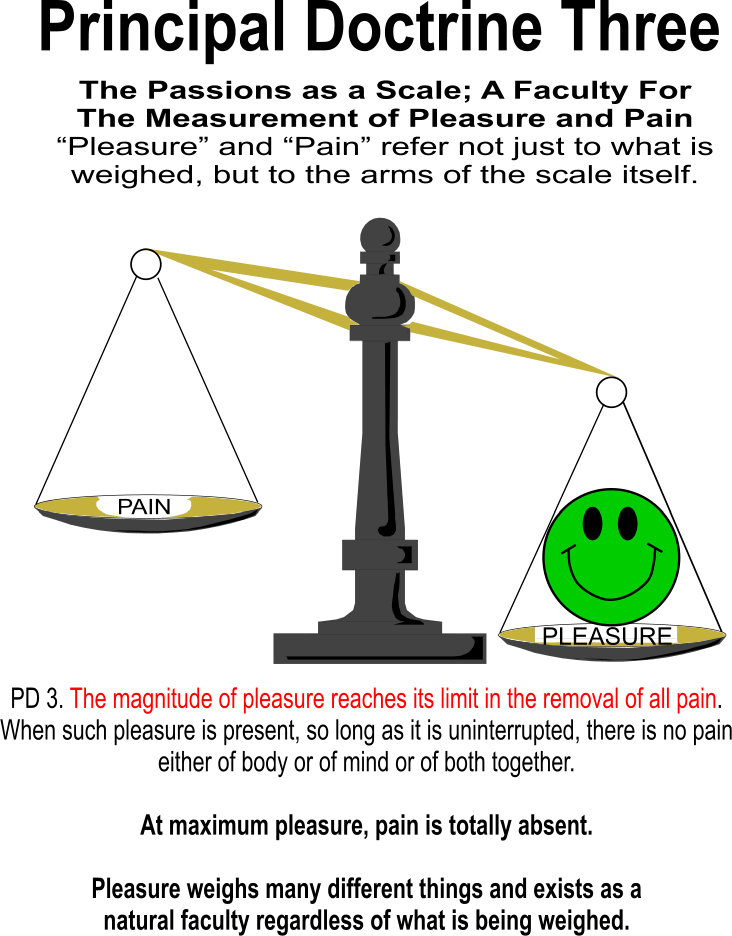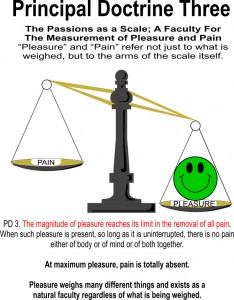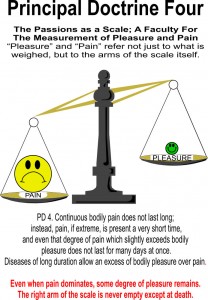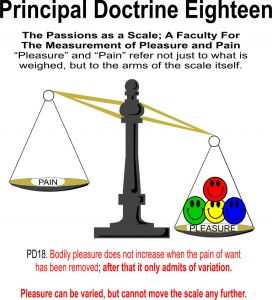Three Diagrams On The Faculty of Pleasure And Pain, Illustrating Principal Doctrines Three, Four, And Eighteen
Here are three diagrams I have drafted to use as aids in discussing Principal Doctrines Three, Four, and Eighteen. I hope to refine these much further, so if you have any comments, suggestions, criticisms, etc, please let me know. (If the diagrams are not sharp, click on them to get full size.)
- One of the key points here is that on the scale of pleasure, pleasure can only be measured up to a certain point on the scale, at which point the limit is reached. The items that give pleasure can be substituted and changed (PD18) but the maximum limit of the scale remains the same and cannot be extended.
- It would probably make for a better diagram to have a scale with a pointer, showing that the scale has a maximum reading. In this diagram, it needs to be understood that the scale rests on a base, and in each case the diagram is intended to convey that the scale can go no further in either direction.
- Another key point is that so long as life continues, the scale performs its function. Only at death does the scale cease to exist and cease to register any pleasure whatsoever.
- In the diagram for PD18, I did not place a logo for any pain at all. Regardless of whether such a state is theoretically possible, in practical terms human life is always going to require a minimum and continuing need for air, water, food, and similar basics to sustain life.
- And all this goes to illustrate why I detest all the ambiguity and confusion surrounding the word “hedonism” and refuse to use it myself. It appears to me that Epicurus most certainly did not preach that we should follow silver, gold, wine, women, or song. All of those may bring pleasure depending on context, but they may also bring pain depending on context. What Epicurus advised us to do is to pay heed to the SENSE that Nature gave us, to the FACULTY of being able to perceive a certain aspect of any object of our consideration, just as we follow our eyes and eyes. The Sense of Pleasure is therefore best seen as a faculty which provides data that we can consider and evaluate, in context, just as we evaluate what our eyes or our ears tell us about the same context. The divine pleasure that is guide of life is not reducible to any particular physical object or objects, no matter how much the enemies of Epicurus would have us believe that our texts teach otherwise. To follow pleasure is to follow the specific guidance of Nature, and to thereby see through all the smoke of “virtue” that the academics are all too happy to define for us.
- By the way, I would hypothesize that there is a direct analogy here between this illustration of the functioning of “the passions” and the functioning of “anticipations.” In the passions, the “gravity” or the natural force that determines whether a thing is pain or pleasure, and the “weight” to which the passions assign to it, is pre-programmed by nature. At birth there is no “content” for the scales, but the mechanism is present in rudimentary form and performs with greater accuracy with use and age. Just so with the mechanism that allows us to perceive “anticipations” or “preconceptions.” We are born with no “cognitive content” – no innate “ideas” – but we are born with a mechanism that is present for the perception and weighing according to natural principles of pre-conceptual data. This anticipatory data, without injection of opinion, is then turned over to our minds for further processing and evaluation along with the data from the “passions” and sight and sound and the other senses that go along with our consideration of any matter that comes to our attention.




